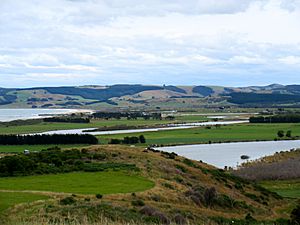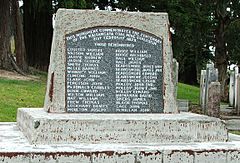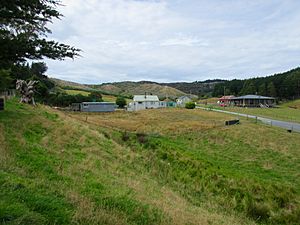Kaitangata, New Zealand facts for kids
Quick facts for kids
Kaitangata
|
|
|---|---|
| Country | New Zealand |
| Region | Otago |
| Territorial authority | Clutha District |
| Ward | Kaitangata-Matau |
| Government | |
| • Type | District Council |
| • Body | Clutha District Council |
| Area | |
| • Total | 2.54 km2 (0.98 sq mi) |
| Population
(2018 Census)
|
|
| • Total | 753 |
| • Density | 296.5/km2 (767.8/sq mi) |
| Postcode |
9210
|
| Area code | 03 |
| Local iwi | Ngāi Tahu |
Kaitangata is a town near the coast of South Otago, New Zealand, on the left bank of the Clutha River ten kilometres south east of Balclutha. The town is known to its residents simply as Kai.
In June 2016 the town gained international attention when new low cost housing was offered there, and local mayor of Clutha District, Bryan Cadogan, estimated there were 100-1000 job vacancies in the region; the news was carried by The Guardian and TVNZ's Seven Sharp.
Contents
Location

The town sits close to the coast on one of the branches of the Clutha River's delta. The small island of Inch Clutha lies immediately to the southwest of the town. Close to the town to the north lies the small Lake Tuakitoto, which drains into the Clutha via a small stream which runs to the west of Kaitangata.
Demographics
In 1863 there were only 29 eligible voters in the wider district, which included Inch Clutha and Matau. By 1865 the population for the wider area was given as 403 males and 253 females – a total of 656. Considerable expansion took place with the arrival of rail and the local population sought to have the town proclaimed a Municipality in July 1878. Kaitangata was within Bruce County at the time.
Kaitangata is described by Statistics New Zealand as a rural settlement. It covers 2.54 km2 (0.98 sq mi), and is part of the larger Kaitangata-Matau statistical area.
| Historical population for Kaitangata | ||
|---|---|---|
| Year | Pop. | ±% p.a. |
| 2006 | 810 | — |
| 2013 | 756 | −0.98% |
| 2018 | 753 | −0.08% |
Kaitangata had a population of 753 at the 2018 New Zealand census, a decrease of 3 people (−0.4%) since the 2013 census, and a decrease of 57 people (−7.0%) since the 2006 census. There were 324 households. There were 393 males and 363 females, giving a sex ratio of 1.08 males per female, with 138 people (18.3%) aged under 15 years, 120 (15.9%) aged 15 to 29, 396 (52.6%) aged 30 to 64, and 99 (13.1%) aged 65 or older.
Ethnicities were 90.8% European/Pākehā, 17.1% Māori, 1.6% Pacific peoples, 1.6% Asian, and 0.4% other ethnicities (totals add to more than 100% since people could identify with multiple ethnicities).
Although some people objected to giving their religion, 67.7% had no religion, 21.9% were Christian and 1.6% had other religions.
Of those at least 15 years old, 21 (3.4%) people had a bachelor or higher degree, and 237 (38.5%) people had no formal qualifications. The employment status of those at least 15 was that 327 (53.2%) people were employed full-time, 75 (12.2%) were part-time, and 36 (5.9%) were unemployed.
Kaitangata-Matau statistical area
Kaitangata-Matau covers 163.71 km2 (63.21 sq mi) and also includes Inch Clutha and Wangaloa. It had an estimated population of 1,140 as of June 2022, with a population density of 7 people per km2.
| Historical population for Kaitangata-Matau statistical area | ||
|---|---|---|
| Year | Pop. | ±% p.a. |
| 2006 | 1,137 | — |
| 2013 | 1,104 | −0.42% |
| 2018 | 1,092 | −0.22% |
Kaitangata-Matau had a population of 1,092 at the 2018 New Zealand census, a decrease of 12 people (−1.1%) since the 2013 census, and a decrease of 45 people (−4.0%) since the 2006 census. There were 441 households. There were 564 males and 528 females, giving a sex ratio of 1.07 males per female. The median age was 40.4 years (compared with 37.4 years nationally), with 213 people (19.5%) aged under 15 years, 210 (19.2%) aged 15 to 29, 543 (49.7%) aged 30 to 64, and 126 (11.5%) aged 65 or older.
Ethnicities were 89.3% European/Pākehā, 15.1% Māori, 1.6% Pacific peoples, 4.4% Asian, and 0.8% other ethnicities (totals add to more than 100% since people could identify with multiple ethnicities).
The proportion of people born overseas was 8.5%, compared with 27.1% nationally.
Although some people objected to giving their religion, 65.4% had no religion, 24.2% were Christian, 0.5% were Hindu, 0.3% were Muslim, 0.3% were Buddhist and 1.1% had other religions.
Of those at least 15 years old, 48 (5.5%) people had a bachelor or higher degree, and 306 (34.8%) people had no formal qualifications. The median income was $31,000, compared with $31,800 nationally. 75 people (8.5%) earned over $70,000 compared to 17.2% nationally. The employment status of those at least 15 was that 480 (54.6%) people were employed full-time, 114 (13.0%) were part-time, and 42 (4.8%) were unemployed.
Transport
Initially access to Kaitangata was by boat up the Clutha River. When road access was being improved at considerable expense in 1862 there was opposition in favour of a steamer service on the river. In 1862 the town was described as a port of entry with a customs house.
Road access remained problematic up until the mid-1870s due to poor construction and surface flooding. A rail link (the Kaitangata Line) to the South Island Main Trunk was constructed in 1875, primarily for moving coal. Prior to the construction of the line, the coal had been shipped down the Clutha River.
Origins
Name
The origin of the town's Māori name is uncertain. It is the name of a figure in Polynesian mythology, but could also refer to cannibal feasts held after tribal fighting in the district between Kāi Tahu and Kāti Mamoe. The name can be interpreted from Māori to English as, 'food for people' or 'people for food'. After the mining disaster in 1879 a local newspaper commented pointed out the meaning of the name and its appropriateness in the circumstances.
European settlement
With the arrival of Europeans, in 1847 the area of land known as the Otago Block, lying between the Clutha and the Tokomairaro Rivers, was surveyed by a party that consisted of Joseph Thomas, R J Harrison, and Charles Henry Kettle, surveyor. The surveyors identified the present location of Kaitangata as suitable for a village on their map. When Europeans settled in the area through the early 1850s, sheep and dairy farming were started. The town's first settler in 1855 was John Lovell.
Coal had been discovered in the nearby area in 1844 by Frederick Tuckett at Coal Point, but access meant that it mining did not commence until the late 1850s. At Kaitangata mining began in 1862 just after the township commenced with the sale of its first 40 sections on 28 February 1862. In August 25 sections were sold in the township for an average of £14 per section. The Presbyterian Church acquired a site for a church in late 1862. Mr James Kirkland was the first Minister appointed on 10 September 1863. The town by 1862 had a customs house, a police station, and stores, and by 1863 a resident magistrate. Andrew Chapman was the first Post Master, appointed on the 15 September 1863. Chapman was later adjudged bankrupt because he was not a competent businessman and a new Post Master was appointed on 1 February 1865.
A primary school was established in 1866 and its roll reached 50 pupils in April 1873. Flax mills were opened in early 1870. In November 1870 a Volunteer Unit, part of the No 1 Clutha Rifles, was formed. A saw mill had been established sometime before 1872. In 1873 a town library was commenced. Cheese manufacturing was commenced. A minor property boom occurred in 1875-1876 with the arrival of rail in the town with section selling anywhere up to ₤100 by June 1876. The telegraph arrived some time in 1877 and a new Presbyterian Church opened in October that year.
Coal Mining
An initial report on coal in the nearby area at Coal Point was carried out by J G Lewis in 1859. This was followed by Dr Hector's survey of the coal fields from 1862-1864 and his report was published in June 1864. In it he identified the area around Kaitangata as being suitable of coal extraction. William Aitchinson had already begun extracting coal near Kaitangata in 1862. In 1871 he leased his mine to John Thompson of Balclutha. He installed a wooden tramway from the mine to the Matau River.
Underground
Coal mining was the mainstay of the town's economy from the 1870s until 1972, when the last state-owned underground coal mine closed. In addition to the earlier mentioned Thompson mine, MacFarlane and Martin opened a new mine in March 1872, with Dunedin merchants Messrs Findlay and Chapstick being added as additional owners a month later. Their mine was referred to as the No 1 Coal Company mine. In September Thompson and Aitchenson reached agreement to raise capital to expand their mining operation by way of a new company, the Kaitangata Coal Mining Company. The Company made a rail link to the South Island Main Trunk at Stirling in 1875.
In September 1873 ownership of the No 1 Coal Company Mine passed to a Mr McLaren. Later the same year Messrs Findlay and Watson opened their mine. The underground mines produced sub-bituminous coal of a high quality, which was used primarily as fuel for the steam locomotives, in use in NZ until the 1960s. When the railways switched to diesel locomotives the decline of underground mining occurred.
Industrial Action
In 1873 miners at the Kaitangata Coal Mining Company struck for higher wages. Their claims were unsuccessful and work resumed after about a month.
Mining Accidents
In either late 1873 or early 1874 the No 1 Company's mine caught fire. By July 1874 the fire had broken out of the mine and attempts to put out the fire were unsuccessful.
One of New Zealand's early industrial disasters occurred at the Kaitangata mine at 8am on 21 February 1879, when the lives of 34 miners were lost in an underground explosion. On the day of the explosion 47 men were employed at the mine. The cause of the explosion is believed to have been a methane gas build up that was ignited when the mine managers brother entered a disused area of the mine with a lit candle. The Coroners Court verdict found negligence on behalf of the mine manager and his brother, together with the lack of legislation as the contributing factors in the disaster.
Open cast
Several open-cast mines have continued to exist (both state and private) up to the present day, such as the Kai Point Mine. The Kai Point Coal Company, founded by George Cross, has been mining coal at Kaitangata since 1951 and produces coal for local industry and domestic heating. It was producing 55,000 tons of coal per annum. The remaining open-cast mine produces lignite, which is primarily used in household fires and industrial boilers.
Railway
In 1873 local residents petitioned the Provincial Government to construct a Branch Line from the South Island Main Trunk to Ropers Creek near Kaitangata to enable coal to be easily transported from the mines. In 1874 the Provincial Government applied for consent to raise a ₤27,750 loan to construct the Branch line with an extension as far as Coal Point. This was unsuccessful and as a result the Kaitangata Coal Company began to investigate constructing its own line.
A railway construction company, the Kaitangata Railway Company was formed and Government consent sought to construct the line. After the Railway Company was formed it amalgamated with the Coal Company, forming the Kaitangata Mining and Railway Company. Construction of a railway line from Kaitangata to the South Island Main line at Stirling was commenced 1875 and was completed on 31 March 1876. It was a private branch line serving the township and the mines. Eventually the line later came into the state Mines Department's possession. It was closed in 1970.
The locomotive that operated the line for many years, known during operation as an "Improved F", was donated to the preservation society at Shantytown in Westland and it operates heritage trains today with the nameplate "Kaitangata" in honour of its former home.
Recent developments
A local promotions society (formed from the former ratepayers' association) has improved this image somewhat and has been responsible for numerous civic projects in and around the town. In 2010 a museum focusing on the coal mining industry was opened.
Kaitangata Promotions house and land package
In May 2016 Kaitangata Promotions began offering a house and land package in Kaitangata for $230,000 In June this story was picked up by other New Zealand media and then following a story in The Guardian became a worldwide media phenomenon. As an indication of the level of interest, By the end of the June daily pageviews for "Kaitangata, New Zealand" on Wikipedia were exceeding those for world cities like Sydney and Los Angeles. The mayor of Clutha district Bryan Cadogan said that "more than 10,000 people" had expressed interest in coming to live in Kaitangata.
Media misinformation
At the beginning of July 2016 some media outlets including the San Francisco Chronicle online edition SFGate began falsely reporting that Clutha District Council was actually giving away houses or money to the value of $160,000 USD to potential residents.
Rules for buyers in scheme
On the 5th of July property sales for the house and land package were temporarily suspended. The incredible response to the scheme, at one point saw more interest in Kaitangata than perhaps any other place in the world, and the real estate agent responsible had received more than 9000 emails regarding it. Accordingly, the promotions group wanted to ensure that it was genuine settlers which were buying the sections and not just speculators.
To achieve this:
Rules would be set, including that successful buyers would need to declare their intention for the land, speculators would not be encouraged, and buyers would agree to build within two years.
Education
Kaitangata School is a co-educational state primary school for Year 1 to 8 students, with a roll of 85 as of April 2023. The school was founded in 1866.
Notable people
- Tony Brown, rugby player and All Black
- Aaron Jury, winner of the Golden Guitar and MLT songwriting awards in 2005
See also
 In Spanish: Kaitangata para niños
In Spanish: Kaitangata para niños




